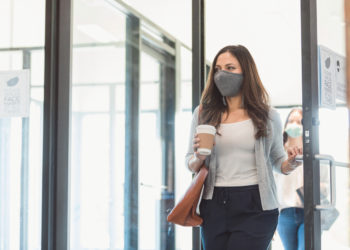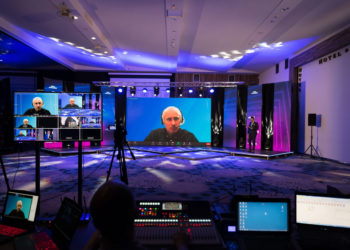Editor’s Note: Today’s post is by Madelyn Stone, the Membership Administrator for the Society for Scholarly Publishing.
As we mark the two-year anniversary of the day many of us were promised the COVID-19 pandemic would be behind us, we are still very much living with the realities of the disease. Some governments are moving to treat the virus as endemic, due to declining case rates along with the availability of vaccines, treatments, and rapid testing. At the same time, we’ve come to learn we cannot predict what new variants and surges will emerge next.
What does that mean for those of us who have become more familiar with Zoom screens than conference rooms? As in-person work and events become reality again, even as new subtypes and fresh waves of COVID-19 emerge, there are countless variables to consider when contemplating a return to business travel and the office commute. Especially as we gear up for the Society for Scholarly Publishing’s (SSP’s) Annual Meeting in Chicago this June, concerns about in-person activities are top of mind.
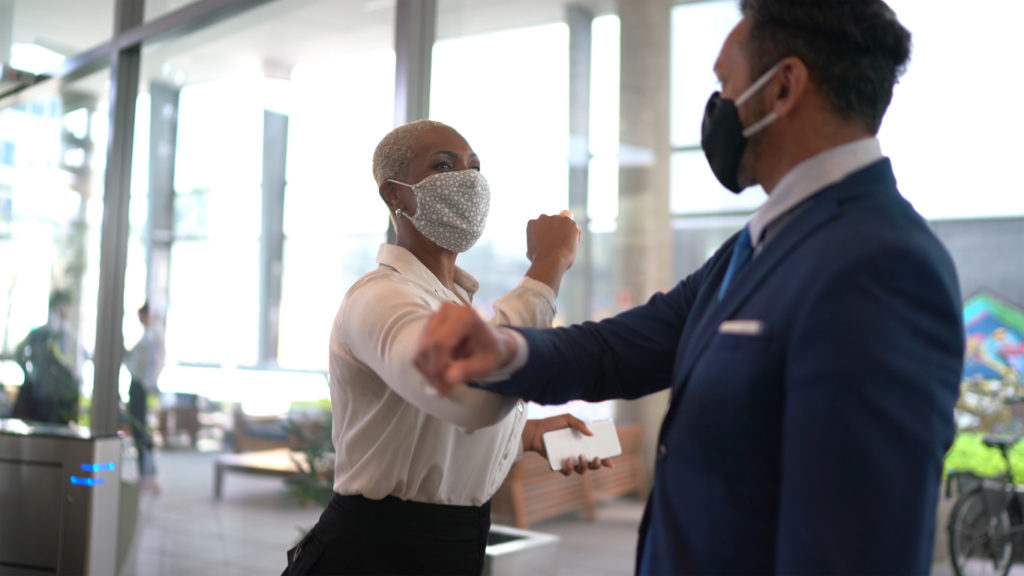
In February of this year, SSP sent out a 10-question survey asking about your plans for travel, returning to the office, and attending in-person events. Many thanks to the 273 of you who responded! What we found, in the wake and continuing waves of the pandemic, was that expectations around working and attending events are in flux. We saw a wide range of comfort levels with in-person activities, though a few common themes emerged. More than 80 percent of respondents, for instance, indicated a vaccination requirement would make them feel comfortable coming to an in-person event. And all of our respondents indicated that, at one point or another, pandemic conditions had necessitated remote work.
Though the vast majority of respondents were based in the United States, we heard from folks around the globe, including Bangladesh, Belgium, Canada, China, Denmark, France, Germany, India, Nigeria, South Africa, and the UK. Almost half (47 percent) work for a society/association/non-profit publisher. Another 19 percent work for an industry service provider, 9 percent for a commercial publisher, and 7 percent in consulting. Libraries, university presses, universities, and government institutions were also represented as employers.
What do work environments currently look like in this landscape? Nearly 18 percent of respondents reported they had never stepped foot into an office for work, even prior to the pandemic. For 26 percent, working remotely had become a permanent change, with no plans to return to the office. Another 24 percent said they had begun returning in-person, but still did at least 60 percent of their work remotely. A small fraction reported working in the office more frequently, with 3 percent doing most of their work in-office, and another 3 percent working in the office full-time. A solid 100 percent indicated they had performed at least some of their work from home during the pandemic.
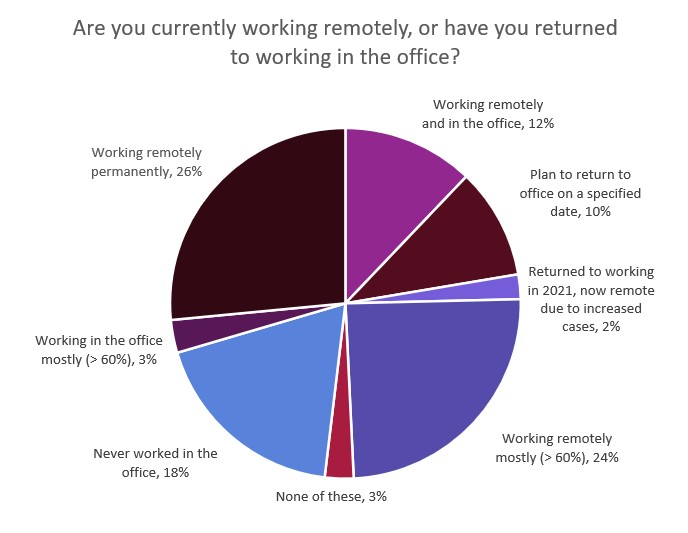
Respondents were divided on their plans to attend in-person events, and on what conditions would make them feel comfortable taking part. There was a close split in opinions on mask requirements for vaccinated attendees: 57 percent said they would be comfortable with optional masking, while 43 percent preferred mandating face masks. The percentage of those who preferred mandatory face masks went up to 47 percent if vaccination was not necessarily required. About 40 percent wanted to see low case numbers in the event location, with 24 percent desiring low case numbers globally. Pre-packaged foods, temperature checks, limited attendee numbers, and outdoor-only activities were a priority for a minority — less than 15 percent marked those as protocols they would have to see before attending an event. Just 2 percent said the event would need to be alcohol-free.
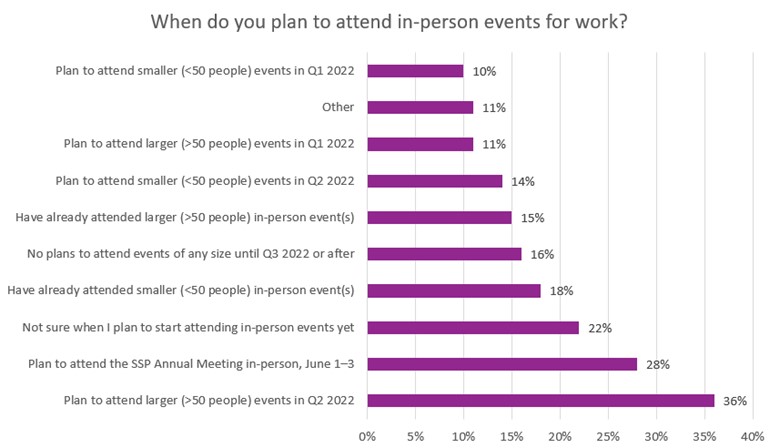
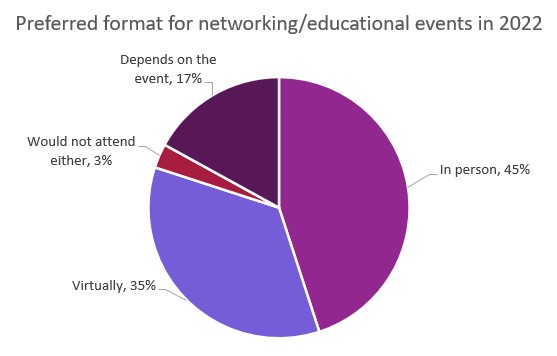
Most respondents indicated that, despite the persistence of pandemic conditions, they plan to attend in-person events at some point in 2022. Some have already begun to do so: 15 percent had attended events with more than 50 people, and 18 percent had already participated in smaller events. Approximately 22 percent were unsure about when they plan to start attending in-person events, and 16 percent said they have no plans to attend events of any size until the third quarter of 2022 or later. About 22 percent reported they had no plans to travel by air for work-related reasons this year. Personal choice dictated these decisions for 77 percent of respondents. Company policy also played an important role, affecting travel, office work, and event attendance for more than 55 percent.
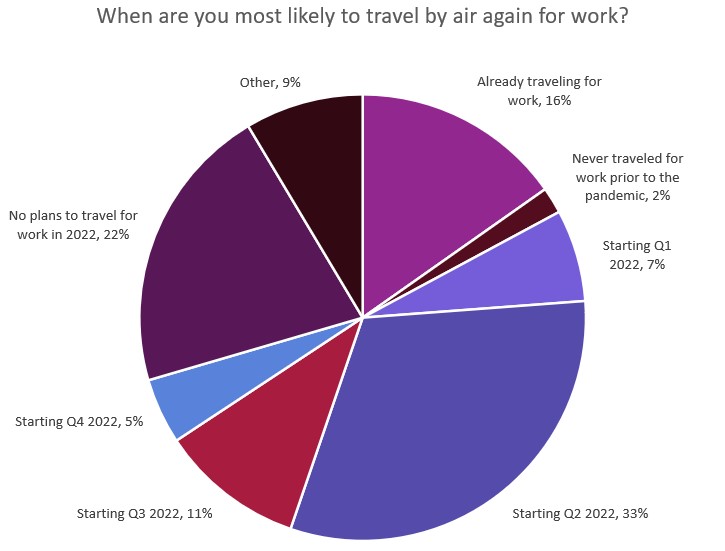
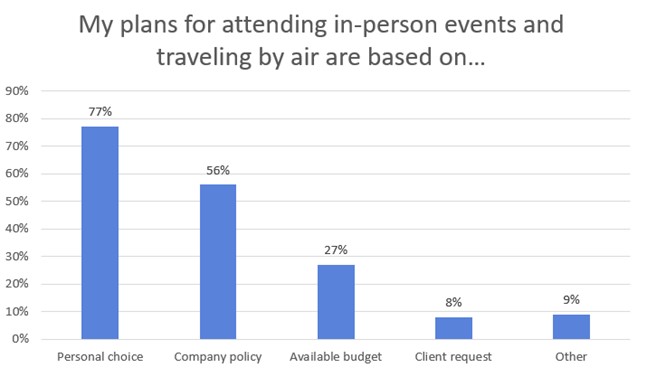
These results capture a narrow slice in time, within a landscape that’s constantly evolving. Since SSP sent out the survey in February, the World Health Organization announced that the Omicron subvariant BA.2 had become the dominant form of COVID-19 worldwide, and the UK has identified a new COVID variant, omicron XE, which may be the most contagious form of the coronavirus yet. Further, this week’s changes in masking requirements for public transportation and air travel will also likely mpact plans for many. Since the end of 2021, the percentage of frequent business travelers who report they have no plans to hit the road has ticked higher: 42% in February 2022 as compared to 39% in October 2021, according to Morning Consult. Analysts are calling the state of business travel “forever changed,” with a Bloomberg survey of 45 large businesses in the U.S., Europe, and Asia showing that 84 percent plan to spend less on travel going forward.
Despite the uncertainty and justified hesitancy, our survey respondents expressed hope and enthusiasm for the prospect of returning to the physical world. Many of you thoughtfully shared additional insights into your perspectives and priorities. Safeguards against contracting COVID-19 were a common theme. Vaccination, masks, hand sanitizing stations, and outdoor activities were the top measures preferred to stop the spread. Several respondents referenced personal factors behind their hesitancy. Those with children under 5 or who have compromised immune systems understandably expressed unwillingness to attend events even with mandates for vaccination and mask-wearing.
Several respondents shared that the nature of the event factored heavily into their decision to attend. Educational programming works about as well virtually as in person, many of you said. But for events with the primary function of networking, the ability to attend in the real world was of high value.
With registration underway for this year’s Annual Meeting, we have some additional insights into the scholarly publishing community’s plans for travel and attending events. So far, the majority of registered attendees are choosing to travel to Chicago, with a small minority opting to attend virtually. A total of 28 percent of survey respondents indicated they plan to join us in Chicago. Your concerns about safety protocols helped shape our policies for the meeting, which will abide by local ordinances and require proof of full vaccination against COVID-19. Masks will be strongly encouraged for all attendees while indoors and not eating, drinking, or presenting.
All in all, it’s unclear what these discoveries mean for the future of work, travel, and in-person events. Enthusiasm for in-person networking events is high, but the risks remain real and the state of the pandemic continues to evolve. As one respondent put it, “I’m vaccinated and boosted. I’ll wear a mask as needed or as feels safer. And conditions now could be quite different when Chicago rolls around. We’ll see…”
Discussion
1 Thought on "Guest Post — Results of the 2022 Survey on Travel, Events, and Return to Office Plans"
Another aspect that I find interesting, is the large number of companies that are reducing their office space, or eliminating the buildings completely. In the short term it will do wonders to the bottom line, but how cohesive will these organizations be without frequent interactions between staff? (I’m not saying it’s impossible to achieve, just different and requires effort).


